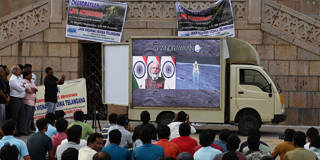How India's relationships with its partners and rivals, and its global role more broadly, evolve remains to be seen. But the country’s achievements in space – most recently the first-ever landing of a lunar rover on the Moon's south pole – undoubtedly strengthen its diplomatic hand, not least because of the respect they inspire in other countries.
NEW DELHI – In 2014, after the Mars Orbiter Mission, known as Mangalyaan, made India the first Asian country to reach Mars orbit, and the first country ever to do so in its maiden attempt, The New York Times published a cartoon. Well-fed Westerners lounged inside a house labeled “Elite Space Club,” while India, represented by a turbaned peasant with a cow in tow, knocked on the door. It was a patronizing and racist image, and it triggered a furor in India.
Now, the Chandrayaan-3 mission has made India the first country to land a lunar rover on the Moon’s south pole, and a new cartoon began making the rounds. This time, the peasant and his cow are inside the house, now labeled “Moon South Pole,” while Americans, Russians, and others line up at the door, rockets in hand, to request admission.
Indians are proud of their space program, for good reason. One of the world’s oldest and most ambitious, it arose from the Physical Research Laboratory, established in Ahmedabad in 1947, the year of India’s independence and brutal partition with Pakistan. In 1962, India’s visionary first prime minister, Jawaharlal Nehru, created the Indian National Committee for Space Research (INCOSPAR), marking the country’s official entry into space exploration. In 1969, INCOSPAR became the Indian Space Research Organization.

NEW DELHI – In 2014, after the Mars Orbiter Mission, known as Mangalyaan, made India the first Asian country to reach Mars orbit, and the first country ever to do so in its maiden attempt, The New York Times published a cartoon. Well-fed Westerners lounged inside a house labeled “Elite Space Club,” while India, represented by a turbaned peasant with a cow in tow, knocked on the door. It was a patronizing and racist image, and it triggered a furor in India.
Now, the Chandrayaan-3 mission has made India the first country to land a lunar rover on the Moon’s south pole, and a new cartoon began making the rounds. This time, the peasant and his cow are inside the house, now labeled “Moon South Pole,” while Americans, Russians, and others line up at the door, rockets in hand, to request admission.
Indians are proud of their space program, for good reason. One of the world’s oldest and most ambitious, it arose from the Physical Research Laboratory, established in Ahmedabad in 1947, the year of India’s independence and brutal partition with Pakistan. In 1962, India’s visionary first prime minister, Jawaharlal Nehru, created the Indian National Committee for Space Research (INCOSPAR), marking the country’s official entry into space exploration. In 1969, INCOSPAR became the Indian Space Research Organization.